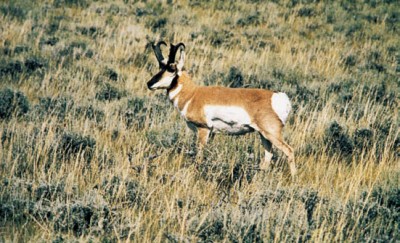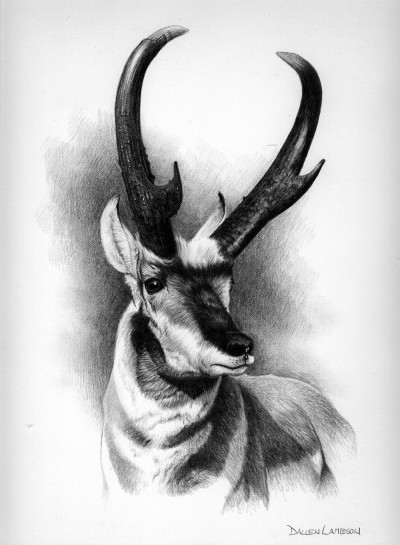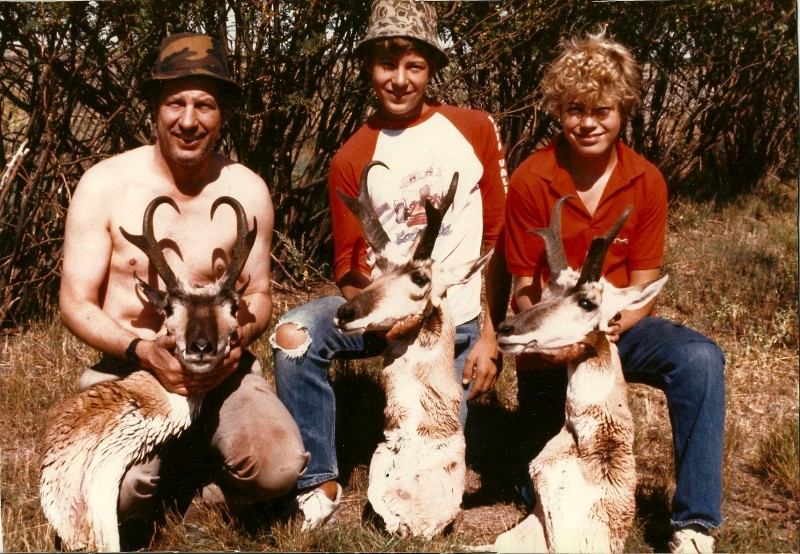The BAREBOW! Chronicles: The Lightning Buck Makes a Triple Play
Dennis Dunn 02.17.14

Sad to say, but—for reasons that are not at all important today—Jeanne and I went our separate ways at the beginning of September, 1985. A few years later, we both remarried (very happily), and the two of us are still friends. Every two years we manage a rendezvous (with spouses in tow) at the biennial Pope and Young Convention, which is where we had met in 1981.
Our original plans for September of 1985 had involved taking my two sons with us for their first antelope hunt, and the destination was once again Steve Gorr’s hunting camp at the Smith Sheep Ranch near Douglas, Wyoming. About 10 days before their new school year got under way, Bryant, Reagan, and I (less Jeanne) piled our camping and hunting gear into my Blazer and sallied forth for pronghorn country. It was, in fact, their very first bowhunt for any big game animal, and to say they were excited doesn’t tell the half of it. We had spent the summer attending every 3D archery competition we could find on the weekends, and I had even insisted that the boys practice shooting off the roof of our garage at targets on the lawn below. I made them shoot broadheads, as well as their normal field points, so there would be no last-minute surprises when the arrows began flying in Wyoming.
I gather that nothing very unusual or exciting happened during our first two days at the Smith Ranch, because sifting through the sands of my memory bank has yielded no concrete recollections. Day three, however, turned out to be one of those days that just stays in your mind forever, and not even Father Time has a chance of prying it out of your cerebral cortex. Just before daybreak, Steve delivered Reagan to the vicinity of the water hole he’d been staking out; I drove Bryant to his “hot” location; then I managed to follow Steve’s hand-drawn “map” to within a couple hundred yards of the new windmill from which he wanted me to try hunting. It was a very tall one, surrounded by some pretty hilly terrain (for antelope country, anyway), and I was able to park my rig not far away, out of view of the shallow basin in which the windmill was situated.
The early-morning sky was cloudless, and I resigned myself to the thought that the sun was unlikely to show me any pity all day. Before the long climb up to my roost (I was guessing about 35 feet, or a bit more), I paced off the distance to my water hole. It was just 20 yards to the nearest corner where an animal could drink, but it was fully twice that to the farthest corner. The pond was larger than most I had seen on the ranch, and the long axis was running straight away from the windmill. If a Pope and Young buck chose that farthest nook of water for his daily pit-stop, it would be a challenging shot, for sure, for a barebow shooter like myself. Unlike today, virtually everybody back then shot a bow with three fingers on the string, and 40 yards was a demanding shot for nearly anyone—especially from the top of a tower.
In the course of the warm morning hours, a number of antelope came and went from my watering hole. They alternated, more or less, with sizable flocks of sheep. It seemed to me as if the antelope had a certain disdain for the domestic livestock, and didn’t really care to mingle with them much. Several small bucks had come in, but nothing I could get excited about. This time I really wanted to hold out for a trophy animal, even if it meant going home without any at all.

Spending a whole day up in the sky, without being able to move around more than a few inches, requires a frame of mind—or shall we say, a mind-set—that only the passions of the hunt can nurture. The often-spinning blades of the windmill are right at your back as you constantly scan the long, 360-degree horizon that surrounds you. The platform you sit or stand on may be comprised of only a total of four or five square feet, and your freedom of motion is extremely limited. It is a healthy idea to slip several acrophobia pills into your oatmeal before you leave camp in the predawn half-light. Windmill sitting is not for the timid. And it can be rather terrifying, if a stiff breeze comes up and you’ve been unable to disconnect (temporarily) the water-pumping rod from the assembly attached to the rotating blades!
As the heat of mid-afternoon arrived, and old Sol did his level best to melt the iron of my will and the metal of my patience, nature’s call became more than my one-pint pee-bottle could handle. Glad for an excuse to descend from the heights and stretch my legs a bit, I found the warm smells of Mother Earth and her pungent sagebrush almost overwhelmingly welcoming. I had waited to climb down until there were no antelope anywhere in sight. Hoofing it quickly back to my Blazer, I chose a spot on the shady side to add a bit of fertilizer to the Wyoming landscape and then hurried back to the water hole—hoping desperately to regain my lofty perch before any more “speed-goats” came over my horizon into view.
When I had just three feet of ladder left to climb, my searching eyes happened to “nail” the head-and-horns silhouette of a dandy buck standing on the high skyline above and behind me. Had I already been “nailed,” as well? That was the big question. Ever so slowly, I completed the ascent, shrank my silhouette down as small as possible, and began the motionless waiting-game that was to become a three-hour, two-sided vigil. Through binoculars, I saw my quarry bed down in full view of both me and the water hole. I could tell that his horns would most likely qualify him for the archery records book, but it was their special character that made me really want this buck—even if he didn’t quite meet the Pope and Young standard.
The solid ebony of his horns turned to ivory at the tips, and after rising about six inches above his ears they turned over, inward, and pointed nearly straight down. The set of horns looked like a perfect heart-shape and really struck me as unusually beautiful. This buck possessed class and a certain aristocratic air. I vowed I would do whatever it might take to win this contest that had just begun.
He had bedded right at 4 p.m., some 400 yards away. Around 6:30, he got up and started walking at right angles to my line of sight. A secondary ridgeline soon obscured him from my view for a while, but before long he reappeared, having circled around to a point about 100 yards off to the right of the big pond. At that moment, the water hole was largely at the mercy of about 40 bleating sheep, so the buck just stood there for a while, simply watching the noisy goings-on. Once the majority of the sheep began trailing off and away, my quarry came in most hesitantly the remaining distance to the water’s edge—about halfway between the nearest and farthest corners of the pond.
For some reason, though, he would not drink. He stood nervously, watching the other nearby sheep that were still, quite obviously, a source of irritation to him. Then, suddenly, he turned and walked back the way he’d come, deciding to postpone the quenching of his thirst until he felt more comfortable about taking the risks involved. Never are wild animals in greater danger, of course, than when they try to take a drink. What maximizes their vulnerability is not just the fact that with head down at ground level, their vision is greatly impaired, but also that it is a situation in which the sounds occurring within their heads as they guzzle water make it much harder for them to hear any approaching danger. On top of that, while they’re drinking, they are not breathing regularly either, so their olfactory protection is significantly reduced. Thus, all three of their top sensory defense weapons are temporarily more-or-less disabled.

My handsome buck retired to a distance of around 75 yards and bedded down in the sage. Since I could see him easily from my lofty platform, escaping the notice of his much keener eyes was my biggest challenge—for the moment. What was starting to worry me even more, however, was the storm coming in from my left side. I was beginning to hear thunder in the distance, and soon the bolts of lightning began striking ridgetops only a few miles away. The odd thing was that there was little to no wind. Things were eerily silent. I had the feeling the storm was being born right around me. The sun had disappeared, and black clouds were massing over my head.
A lightning bolt suddenly descended to a hilltop just a mile away. When my scalp began to feel a bit creepy underneath my camo cap, I realized the situation was becoming downright dangerous. Then, just at the very moment I made the rational decision to abandon my metal lightning-rod of a windmill, Mr. Pronghorn rose from his bed and started trotting toward the water hole. Nary a sheep was left. He made a beeline for the farthest corner of the pond and immediately lowered his head, his spine pointing directly toward me. This time he seemed in a hurry, not even bothering to make the usual feint with his head before settling in for a long drink. By now the angriest of the dark clouds were nearly overhead, and I knew all I wanted to do was get the shot off and then get down out of that tower before I got turned into a crispy critter.
The broadside shot I had hoped for was clearly not going to be there. It was now a very narrow target at 40 yards, and I really didn’t want to hurry the shot. I knew that—if I made a poor release and missed him—I’d be “fried,” as they say, but then I might be fried, regardless, if I didn’t hustle down out of that windmill. Not wishing to have spent 12 hours up there for nothing, I decided that staying a few seconds longer was worth the risk. As the arrow left the bowstring, my princely pronghorn snapped his head up to gaze in the direction of the sound. The broadhead—angling steeply downward—clipped the hide on the bottom edge of his jaw, entered the top of his rib cage, and exited under his left armpit.
Instantly, as my shaft passed through his vitals, he did a backward somersault and landed with all four legs churning, carrying him from zero to 50 in two seconds flat. I remained on my platform only long enough to time his short, lightning-quick death-run. In the five seconds it took, he covered 83 yards (actual paced distance). As I hurried down the ladder toward the welcoming earth, I could feel the electricity in the air. I simply knew I had to get away from that tower as quickly as possible.
Only once before—many years earlier—had I experienced this foreboding sensation. Two college mountaineering buddies and I had just completed climbing the face of the Crestone Needle in Colorado. Hauling ourselves up onto the summit rock, we looked at each other and saw that everybody’s hair was standing straight up! Each of our steps sizzled underfoot, as if we were on a hot griddle. Fortunately, there was an easy way off the top of the peak, but I doubt we were much more than 100 yards below the summit when it got nailed by a huge lightning-ball of fire.
The Wyoming speed-goat had not escaped my own brand of lightning, but—as I high-tailed it for my rig—the hill behind me, on which he’d bedded for much of the afternoon, was struck hard by another one of Zeus’s javelins. Five or six minutes later, I had maneuvered my Blazer around the pond and across the sage flat to where my prize Pronghorn lay waiting for me, stone dead. Just as I was swinging him up into the back of my vehicle, another bolt hit simultaneously with the thunderclap and stripped the platform right off the top of the tower I had spent all day making friends with.
All that remains to tell is the wonderful story of my triumphant return to the ranch that night. By the time I finished working out how to drive the roads backward that were traced out on Steve’s hand-drawn map, it was pitch dark. I finally turned onto the gravel road leading to our tent site, wondering what sort of luck my sons had had up in their windmills that day. Two small figures suddenly appeared in my headlights, trudging up the road to greet the dad they had started worrying about.
As I pulled up alongside and lowered my window, I heard two voices in unison ask, “Well, did you get one, Dad?”
“He’s in the back,” I replied. “Hop in and tell me all about your day! Did either of you get one?”
“We sure did!” Reagan answered. “We both got one! We were back in camp by 2:30 this afternoon!”
“What took you so long?” Bryant wanted to know, breaking into a broad grin.

After hanging my buck in a tree, we all drove into Douglas for a big steak dinner, some major tale-swapping, and a celebration of our family’s totally unexpected triple-play. What a fabulous father-son bonding experience that Wyoming hunt proved to be! About a month after returning home, Bryant wrote up the story of our hunt, and I mailed a copy to M. R. James, the founding editor of BOWHUNTER Magazine. M. R. liked Bryant’s story well enough to buy it, and the following early summer my son became a published author at the tender age of 16. The boys sure had done their father proud, in more ways than one!
Editor’s note: This article is the seventeenth of the BAREBOW! Chronicles, a series of shortened stories from accomplished hunter and author Dennis Dunn’s award-winning book, BAREBOW! An Archer’s Fair-Chase Taking of North America’s Big-Game 29. Dunn was the first to harvest each of the 29 traditionally recognized native North American big game species barebow: using only “a bow, a string, an arrow—no trigger, no peep sights, no pins—just fingers, guts, and instinct.” Each of the narratives will cover the (not always successful, but certainly educational and entertaining) pursuit of one of the 29 animals. One new adventure will be published every two weeks—join us on the hunt! You can learn more about the work and purchase a copy on Dunn’s site here. Read the sixteenth Chronicle here.

